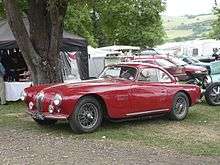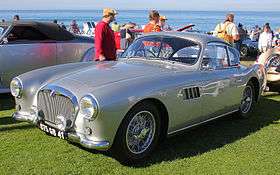BMW OHV V8 engine
| BMW OHV V8 engine | |
|---|---|
|
BMW OHV V8 installed in a BMW 503 | |
| Overview | |
| Manufacturer | BMW |
| Production | 1954–1965 |
| Layout | |
| Configuration | V8 OHV |
| Displacement |
2,580 cc (157 cu in) 3,168 cc (193 cu in) |
| Chronology | |
| Predecessor | - |
| Successor | BMW M60 |
The BMW OHV V8 is an overhead valve (pushrod) V8 petrol engine produced from 1954 to 1965. It is BMW's first V8 engine, and BMW did not produce another V8 automobile engine until the M60 in 1992.
The engine does not have an official model code,[1] therefore it is often identified as being the only overhead valve ("OHV") V8 engine produced by BMW, since all other BMW V8 engines use a DOHC valvetrain.
Although not a direct replacement, in 1965 the 6-cylinder M30 took the OHV V8's place at the top of BMW's engine range.
Development
.jpg)
.jpg)
The BMW 501, which began production in 1952, was the first car produced by BMW after World War II. It was powered by the 2.0 L (122 cu in) M337 straight-6 engine[2](p46)[3] (based on the pre-war M78 engine), which struggled with the 1,285 kg (2,833 lb) mass of the 501. Mercedes-Benz's competing model, the W187, was powered by a larger 2.2 L (134 cu in) engine, which provided superior performance.[2](p46)
However, BMW had been developing a V8 engine since 1949,[2](p46) which was produced in 2.6 L (159 cu in) and 3.2 L (195 cu in) capacities. The design was finalized by Fritz Fiedler when he returned to BMW in 1952.[4](p90)
In 1954, the V8 engine was introduced (in 2.6 Litre form) in the BMW 502 - a higher specification version of the 501. In 1955, the 3.2 Litre version of the engine was introduced in the BMW 3.2, which was based on the 502.
Design
At the time, unique features of the BMW OHV V8 included the aluminium construction of the block and head, and a coolant passage design that increased the block stiffness over typical engines with wet cylinder liners.[2](p48) The layout of the engine is a longitudinally-mounted 90° V8 with cast iron wet liners and stiffening webs between the cylinders.[2](p48) Apart from the materials, the engine was similar in overall design to the Cadillac OHV V8 and Oldsmobile V8 engine of the late 1940s, with a central camshaft using pushrods to operating overhead valves in crossflow cylinder heads with wedge-shaped combustion chambers.[4](p90)[2](p48)
The 2,580 cc (157 cu in) versions have a bore of 74.0 mm (2.9 in) and a stroke of 75.0 millimetres (2.95 in). Initially, this engine used a two barrel Solex 30 PAAJ carburettor, a compression ratio of 7.0:1[4](p91)[2](p49) and had a power output of 75 kW (100 hp).
The extra capacity of the 3,168 cc (193 cu in) version was achieved by increasing the bore to 82.0 mm (3.2 in). The larger engine initially used a single Zenith 32 mm carburetor, a compression ratio of 7.2:1 and produced 89 kW (120 hp). The highest power output version of the BMW OHV V8 produced 119 kW (160 hp) and was used in the 3200 S released in 1961.[4](p93)
Models
The following is a summary of the engine's variants.[5][6](p508)
| Engine | Displacement | Carburettor | Power | Torque | Years |
|---|---|---|---|---|---|
| M502/1 | 2,580 cc (157 cu in) | Solex 30 PAAJ | 75 kW (100 bhp) @ 4800 rpm | 184 N⋅m (136 lb⋅ft) @ 2500 rpm | 1954–1961 |
| M502/100 | Zenith 32 NDIX | 75 kW (100 bhp) @ 4800 rpm | 185 N⋅m (136 lb⋅ft) @ 2500 rpm | 1961–1963 | |
| M502/110, M533 | 82 kW (110 bhp) @ 4900 rpm | 186 N⋅m (137 lb⋅ft) @ 3000 rpm | 1961–1963 | ||
| M506/1 | 3,168 cc (193 cu in) | Zenith 32 NDIX | 89 kW (120 bhp) @ 4900 rpm | 214 N⋅m (158 lb⋅ft) @ 2500 rpm | 1955-1961 |
| M506/140, M534 | Zenith 36 NDIX | 104 kW (140 bhp) @ 5400 rpm | 242 N⋅m (178 lb⋅ft) @ 3000 rpm | 1961-1963 | |
| M503/1 | dual Zenith 32 NDIX | 104 kW (140 bhp) @ 4800 rpm | 220 N⋅m (162 lb⋅ft) @ 3800 rpm | 1956-1961 | |
| M507/1 | 112 kW (150 bhp) @ 5000 rpm | 240 N⋅m (177 lb⋅ft) @ 4000 rpm | 1956-1959 | ||
| M503/160, M532 | dual Zenith 36 NDIX | 119 kW (160 bhp) @ 5600 rpm | 245 N⋅m (181 lb⋅ft) @ 3600 rpm | 1961-1963 |
M502/1
The original 2.6 L version of the engine was developed for the BMW 502 and was introduced with it in 1954.[2](p48)[4](p92) The compression ratio is 7.0:1. A 95 horsepower (71 kW; 96 PS) version of this engine was available in the 501 V8 of 1955.[4](pp250–251)
In 1958, the 501 V8 and 502 were renamed the 2.6 and 2.6 Luxus respectively, with no changes in engine specification.[4](pp250–251)
Applications:[5]
- 1954-1958 BMW 502 (100 hp)
- 1955-1958 BMW 501 V8 (96 hp)
- 1958-1961 BMW 2.6 (95 hp)
- 1958-1961 BMW 2.6 Luxus (100 hp)
M502/100 and M502/110
In the summer of 1961, the 2.6 L engines were uprated with the Zenith 32 NDIX carburetor from the earlier 3.2 L engines and a 7.5:1 compression ratio. With this upgrade, the 2.6 became the 100 horsepower (75 kW; 100 PS) 2600 and the 2.6 Luxus became the 110 horsepower (82 kW; 110 PS) 2600 L. These cars continued in production until December 1963[5]
Applications:[5]
M533
M533 is version of M502/110 with gearbox directly mounted to engine.[6](p151)
Applications:
M506/1
The 3.2 L engine was developed in 1956, and was offered in the 502-based 3.2 from then until 1961.[7][4](p93) The compression ratio is 7.2:1.
Applications:
- 1955-1961 BMW 502 3.2[6](p508)
M503/1 and M507/1
BMW's V8 sports models, the 503 and 507, used M503/1 and M507/1 engines respectively, each with a pair of Zenith 32 NDIX two-barrel carburetors. With these, and a compression ratio of 7.5:1, the 503's engine produced 140 horsepower (100 kW) at 5000 rpm. The tuning of the 507's engine went further, with high-lift cams, a different spark advance curve, polished combustion chamber surfaces, and a compression ratio of 7.8:1, producing 150 horsepower (110 kW; 150 PS) at 5000 rpm.[4](p113) Both models were discontinued in March 1959.[4](p115)
The twin-carburetor engine from the 503 was used in the 502-based 3.2 Super from 1957 to 1961.[8]
Applications:[6](p508)
- 1956-1960 BMW 503 (140 hp)
- 1956-1959 BMW 507 (150 hp)
- 1957-1961 BMW 3.2 Super[8] (140 hp)
M506/140 and M503/160
The single-carburetor 3.2 and two-carburetor 3.2 Super were replaced in 1961 with the M506/140 (140 horsepower (100 kW)) for 3200 L and the M503/160 (160 horsepower (120 kW)) for 3200 S respectively.[4](p93) The increase in power came from larger Zenith 36 NDIX carburetors and a compression ratio of 9.0:1.[9]
Production of V8 sedans ended in 1963,[4](p93) but the engine from the 3200 S was used in the 3200 CS coupé from January 1962 to September 1965.[4](pp131–132)
Applications:[4](p93)
- 1961-1963 BMW 3200 L (140 hp)
- 1961-1963 BMW 3200 S (160 hp)
- 1961-1963 BMW 3200 CS (160 hp)
M532 and M534
M532 and M534 were replacement for M503/160 and M506/140 with gearbox directly mounted to engine.[6](p151)
Applications:[6](p508)[4](pp131–132)
- 1963 BMW 3200 L (140 hp)
- 1963 BMW 3200 S (160 hp)
- 1963-1965 BMW 3200 CS[10] (160 hp)
Use by other manufacturers

Frazer-Nash Continental
Frazer-Nash was an importer of BMW cars into the United Kingdom and had used the Bristol straight-six engine, which was based on the BMW M328. The BMW OHV V8 was fitted to the Frazer Nash Continental model.[11] The Continental was intended to be available with either the 2.6 or 3.2-litre V8, but only a single prototype was ever made, with the 3.2 engine. It was the last motor car Frazer-Nash made.[12](p74)
Talbot-Lago America

The 1955 Talbot-Lago Sport was originally powered by Talbot's own 2.5 Litre 4-cylinder engine. In 1957, due to reliability problems, Talbot switched over to the BMW OHV V8 and renamed the car the Talbot-Lago America.[13]
References
- ↑ "BMW 502 saloon model selection". www.realoem.com. Retrieved 28 May 2017.
- 1 2 3 4 5 6 7 8 Noakes, Andrew (2005). The Ultimate History of BMW. Bath, UK: Parragon Publishing. ISBN 1-4054-5316-8.
- ↑ "1952 BMW 501". www.globalcar.com. Archived from the original on 2 December 2013.
- 1 2 3 4 5 6 7 8 9 10 11 12 13 14 15 Norbye, Jan P. (1984). BMW - Bavaria's Driving Machines. Skokie, IL, USA: Publications International. ISBN 0-517-42464-9.
- 1 2 3 4 "BMW Classic- Recherche-Client". www.bmw-grouparchiv.de (in German). With searches for individual models. Retrieved 9 June 2017.
- 1 2 3 4 5 6 7 Lange, Karlheinz (2000). BMW Dimensions: The History of Engines - Engines That Made History 1945-2000. ISBN 3932169050.
- ↑ "BMW 501 V8 / 502". www.motorbase.com. Archived from the original on 6 June 2011.
- 1 2 "BMW 502 Limousine". www.bmw-classic.com (in German). Archived from the original on 3 December 2013. Retrieved 9 June 2017.
- ↑ "Betribsanleitung BMW 2600, 2600 L, 3200 L, 3200 S". bmw-grouparchiv.de (in German). Retrieved 7 June 2017.
- ↑ Norbye 1984, pp. 131-132.
- ↑ "Snapshot From 1960". www.curbsideclassic.com. Retrieved 9 June 2017.
- ↑ Gunnell, John (2004). Standard Guide to British Sports Cars. Iola, WI USA: Krause Publications. pp. 73–75. ISBN 0-87349-757-0.
- ↑ "Lost Marques: Talbot Lago". www.ucapusa.com. Retrieved 9 June 2017.
« previous — BMW automotive petrol engines: 1940s–1960s — next » | ||||||||||||||||||||||||||||||||||||||||
|---|---|---|---|---|---|---|---|---|---|---|---|---|---|---|---|---|---|---|---|---|---|---|---|---|---|---|---|---|---|---|---|---|---|---|---|---|---|---|---|---|
| 1940s | 1950s | 1960s | ||||||||||||||||||||||||||||||||||||||
| 0 | 1 | 2 | 3 | 4 | 5 | 6 | 7 | 8 | 9 | 0 | 1 | 2 | 3 | 4 | 5 | 6 | 7 | 8 | 9 | 0 | 1 | 2 | 3 | 4 | 5 | 6 | 7 | 8 | 9 | |||||||||||
| straight-4 | M10>> | |||||||||||||||||||||||||||||||||||||||
| straight-6 | <<M78 | M78*>> | M30>> | |||||||||||||||||||||||||||||||||||||
| M337 | ||||||||||||||||||||||||||||||||||||||||
| <<M328 | ||||||||||||||||||||||||||||||||||||||||
| <<M335 | ||||||||||||||||||||||||||||||||||||||||
| V8 | OHV V8 | |||||||||||||||||||||||||||||||||||||||
| *made in the Soviet Occupation Zone by Autovelo | ||||||||||||||||||||||||||||||||||||||||